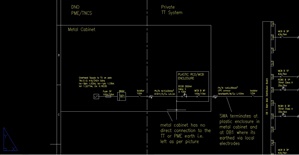Sparkingchip:
The RCD is not the better solution, it is the only solution. Unless you are going to take the TNCS-PME earth connection to where it does not need to be.
Revise that, the RCD is not optional, regardless of the earthing arrangement.
Andy Betteridge.
Chris Pearson:
I see no reason to earth the cabinet, but that switch fuse definitely needs to be earthed. Achieving that via 100 m of SWA and an earth rod seems very odd. In the absence of an RCD it is definitely no better than C2.
What size fuses are in the switch fuse and what is the EFLI at the DB?
Not sure what's in side the fused isolator yet but agree it needs earthed as it stands and with a upfront RCD, my own thought was to replace it with a plastic enclosure and a MCB & RCD (100mA Time delay) within, as the fuse isolator has been noted to be potentially faulty anyway.
The earth fault loop impedance is way too high for anything currently protecting the cable i think my MFT recorded around 10ohm / 25A, but it had been raining a while so the ground was soaked so this was probably best case, but generally speaking i thought it was a good low TT reading.
Sparkingchip:
Take a step back, what if anything is wrong with the Crabtree Fusestar fused switch?
It’s a switch with fuses in it, so let’s rule out the fuses as being faulty as they are a replaceable item and really either they are okay or they aren’t, there is a middle ground.
So if the switch operates and there’s no sign of thermal damage to it it or the fuse holders it doesn’t need replacing, so as the feeder cable is not going to be replaced the Crabtree Fusestar and feeder cable can all be left as it is saving time and money.
we have not been able to look inside the switch yet or operate it to see for ourselves and only had word from the end user that its lever/mech is faulty (repairable/faulty we cannot say yet)
Steve UKBC:Chris Pearson:
What size fuses are in the switch fuse and what is the EFLI at the DB?The earth fault loop impedance is way too high for anything currently protecting the cable i think my MFT recorded around 10ohm / 25A, but it had been raining a while so the ground was soaked so this was probably best case, but generally speaking i thought it was a good low TT reading.
Sorry, that's not really what I meant to ask. What is Ze, and what is R1+R2 of the distribution circuit.
If you don't know what size fuses are in there, how do know "The feeder cable to DB1 some +100m away has not got a low enough impedance to clear a earth fault with the 100A DNO fuses/fused isolator within 5s required by BS7671 ..."
AJJewsbury:
I still think that in a metal box outdoors is far from an ideal location for a delicate device like an RCD - especially one you're going to be totally reliant on for ADS, not just additional/fire protection.
- Andy.
At the other end of the installation there may presumably be RCDs in boxes on top of poles at each camping pitch.
Steve UKBC:Sparkingchip:
Take a step back, what if anything is wrong with the Crabtree Fusestar fused switch?
It’s a switch with fuses in it, so let’s rule out the fuses as being faulty as they are a replaceable item and really either they are okay or they aren’t, there is a middle ground.
So if the switch operates and there’s no sign of thermal damage to it it or the fuse holders it doesn’t need replacing, so as the feeder cable is not going to be replaced the Crabtree Fusestar and feeder cable can all be left as it is saving time and money.we have not been able to look inside the switch yet or operate it to see for ourselves and only had word from the end user that its lever/mech is faulty (repairable/faulty we cannot say yet)
Possibly unfamiliarity with interlocking switches?
Best go and have a look in the morning and put the RCD in the tails whilst you are there ?

We're about to take you to the IET registration website. Don't worry though, you'll be sent straight back to the community after completing the registration.
Continue to the IET registration site